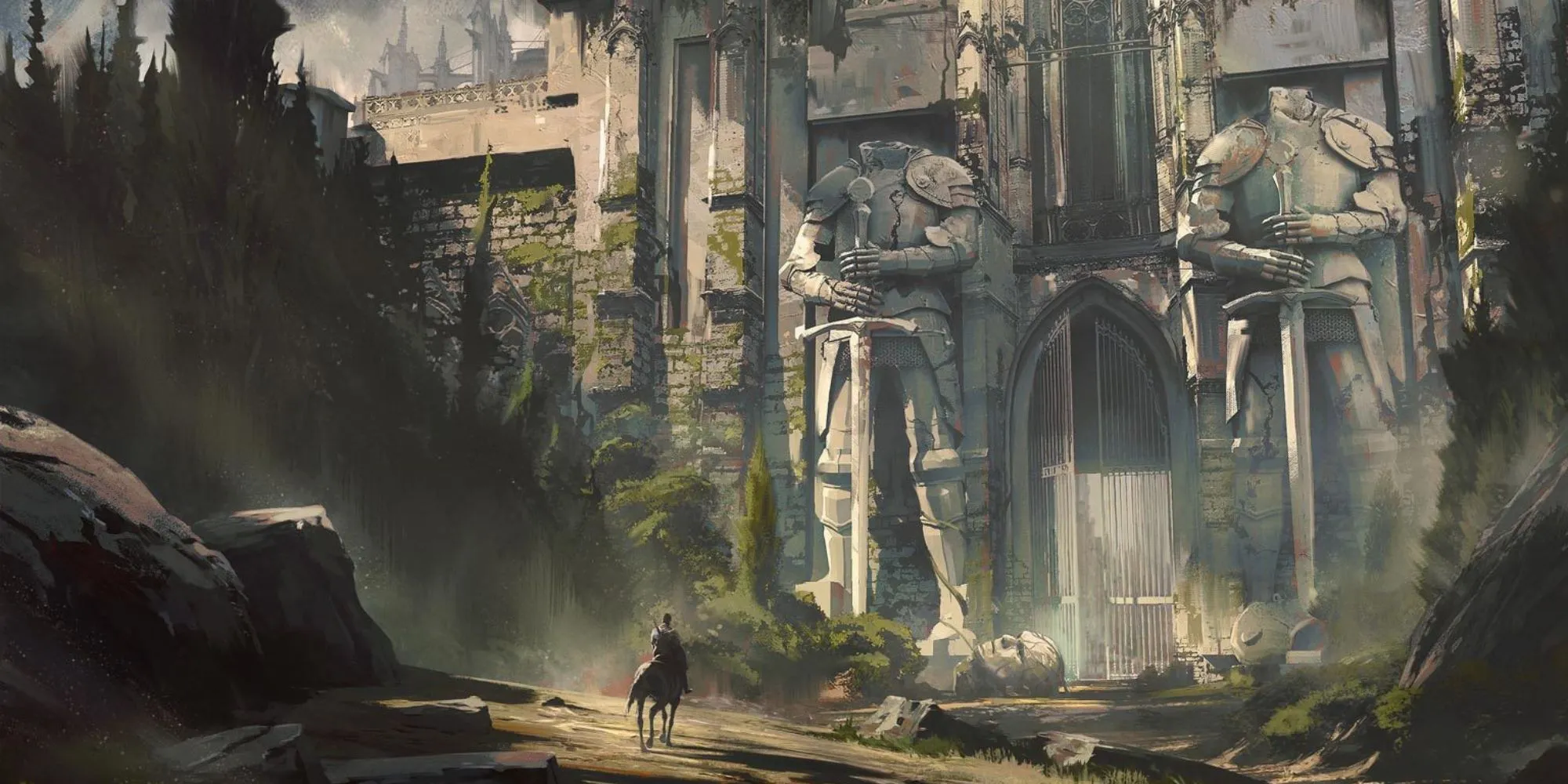Dungeons & Dragons Crafting Unforgettable Castles
Craft Dungeons & Dragons castles with the same level of memorability as those inhabited by its characters.
🏰 Tips for Creating Memorable Castles 🏰
 Illustration by Jedd Chevrier from Dungeons & Dragons Curse Of Strahd
Illustration by Jedd Chevrier from Dungeons & Dragons Curse Of Strahd
Dungeons & Dragons (D&D) is well-known for its fantastical elements and iconic tropes, one of which is castles. Castles play a significant role in the D&D experience, just like in the fantasy genre at large. From the towering Minas Tirith to the foreboding Castle Gormenghast and the imposing Winterfell, the world of fantasy has given us countless memorable castles. But why settle for a generic fantasy fortification when you can create a living, breathing space with its own unique characteristics in your next D&D campaign? Let’s explore some tips for creating truly memorable castles!
What’s The Purpose? 🏰
Defensive capabilities are a castle’s primary function, but they serve other purposes as well. Castles are often strategically located at busy rivers, crossroads, and strategic mountain passes to ensure control over trade routes, traffic, and the movement of enemy armies. Each location offers a distinct atmosphere and attracts different types of inhabitants. From grim martial types in a fortress to servants and courtiers in a decorative urban castle, the people inside can shape the ambiance. Consider the castle’s purpose within your game world. A castle in an active conflict should feel different from one where no immediate threats are expected. Whether it’s a bustling marketplace outside a castle at a busy intersection or a port-side castle with seabirds, salty air, and secret cave docks, the location should enhance the castle’s unique feel.
High Ground 🏞️
Just like Anakin Skywalker, castles favor high ground. Historical castle builders would construct a mound to place their castle on, especially when no natural hill was available. This elevation provided better defense against projectile weapons and siege engines. Even in the magical realms of D&D, people still seek every advantage they can get. While the laws of physics may not apply the same way, it’s essential to make the castle’s positioning believable within the game’s universe. A castle should occupy the most naturally defensive position in the landscape, be it on a hill or another elevated area.

Castle Components 🏰
When designing a castle for your campaign, consider including key components like a keep, curtain wall, towers, and a heavily guarded gatehouse. The keep functions as both the living quarters and the final line of defense. Towers on the outer walls offer observation points and enhance the castle’s defensive capabilities. In the world of D&D, you have the freedom to incorporate magical elements and unique castle components. Some castles may only be accessible through magical portals or by riding on the backs of flying beasts. Let your imagination run wild within the bounds of your game world’s logic.
- Xur Has Arrived! Get Ready for New Exotic Gear in Destiny 2
- Unlocking and Using the Eternity Cache in Last Epoch: Your Path to ...
- Best Builds and Gameplay Guide for Dead By Daylight
Diverse Decor 🏰
Contrary to popular belief, castle interiors were not all bare stone walls in the medieval period. While the plaster and paint may have fallen off over the centuries, the interiors were often brighter and more varied than commonly imagined. Take inspiration from games like Kingdom Come Deliverance, which beautifully showcased the color, detail, and variety of medieval castle interiors. In D&D, you can decide which gods the castle owner favors and decorate accordingly, adding religious motifs on the walls through tapestry or paint. Pay attention not only to the castle’s exterior but also to the character of the castle’s lord, which can be revealed through color, furniture, and decoration choices.
Functional Rooms 🏰
Every room within your castle should serve a purpose, whether it’s grand or mundane. Storerooms, kitchens, servants’ quarters, and armories are all valid uses of castle real estate. Assigning a function to each room allows you to quickly determine who and what occupies them. The lord and lady’s sleeping quarters typically occupy the best room in the keep. Additionally, the keep may house the great hall, dining room, kitchen, chapel, and solar (a private family room usually on the upper floor).
Sensory Feedback 🏰
As a Dungeon Master, it’s easy to focus on the visual and audible aspects of the game world, but remember that ambient noise is a crucial part of our sense of place. When designing your castle, consider the daily processes and movements within it. What background noises would be present? A castle could feature stables, kitchens, courtyards, chapels, and forges, each producing its own unique sensory information. Engaging players with the full range of senses as they move through the castle enhances their immersion in the game.
🌍 Classic Castle Locations 🌍
In the realm of fantasy, practicality is not a limitation when it comes to castle locations. Depending on the level of fantasy in your campaign, you can explore castles straddling active volcanoes, floating on suspended rock formations, or even castles existing on different planes of existence. The possibilities are endless, especially with magical teleportation at your disposal. Create locations that are playable and navigable by the characters in your game, ensuring the castle’s location aligns with its intended function. Here are some classic castle locations to consider:
| Location | Function |
|---|---|
| Active Volcano | An active volcano castle is a Saturday morning cartoon classic for a reason. No location better reflects the volatile malevolence of a despotic bad guy than an active volcano. You can even have it erupt dramatically when the bad guy goes down – like the volcano knows! |
| Mountain Pass | Minas Morgul, one of the most iconic mountain pass castles in fantasy, defends the route into (or out of) Mordor and serves as a vigilant watchtower. Castles in such locations are hard to supply and often uncomfortable. |
| Crossroads | Historical castles were frequently positioned near busy trade routes, which were also the roads armies would march on. Placement at a crossroads allowed lords to collect taxes, accumulate wealth, and access various goods and trade services. |
| Moving Castle | Walking, rolling, and floating castles have been a part of the fantasy genre for a long time. Studio Ghibli’s classic Howl’s Moving Castle showcased the concept beautifully. In D&D, you can explore castles that defy traditional static structures, allowing for unique gameplay experiences. |
| River Crossing | Building a castle at a strategic river crossing grants its lord control over trade and traffic. Depending on its proximity to the sea, such a castle may even feature a shipyard. The Twins, the castle of the Frey family in Game of Thrones, offers an excellent example of a river-crossing castle in fantasy. |
| Clifftop | The ancient Celts built ring forts high on cliffs, facing the ocean. With a sheer drop to one side, these fortifications were easier to defend and almost impossible to flee. However, supplying a remote fortress like this presented its own challenges. |
Remember, the key is to create castle locations that align with your campaign’s tone and mechanics, and that are engaging and immersive for your players. Let your imagination run wild within the bounds of your game world!
📚 References:
- D&D Tips: Help for Players to Make Great Characters
- Kingdom Come Deliverance: The Realities of Historical Accuracy in Gaming
- Building Castles: Making Sense of D&D’s Guide to Strongholds
- Creating a Living Breathing Dungeon
- 10 Iconic Imaginary Castles
Stay creative, fellow gamers! And remember, the only thing more powerful than a castle is your imagination. ✨
👉 Now, we want to hear from you! What’s your favorite castle-inspired moment in your D&D adventures? Share your stories in the comments below and let’s keep the conversation going. Also, don’t forget to share this article with your fellow adventurers, knights, and castle enthusiasts on social media! 👈






